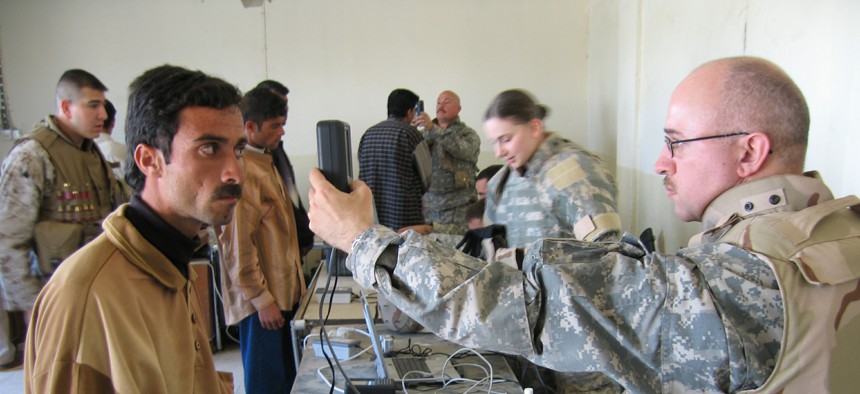
An unidentified U.S. soldier conducts an iris scan on an Iraqi man during an Iraqi army recruiting drive in the city of Ramadi on Monday March 27, 2006. AP / TODD PITMAN
Special Operators Are Using Rapid DNA Readers
Conducting a midnight SEAL raid on a terrorist compound? Positive DNA identification is just 90 minutes away.
TAMPA -- Fingerprints are so 20th-century. For special operations forces conducting midnight raids in places like Pakistan or Syria, DNA is becoming the gold standard.
On Wednesday, representatives from the U.S. Special Operations Command revealed that they were testing two rapid DNA readers in forward locations. The operators feed in a DNA sample, and the reader compares it against a database that matches DNA to identities. The machines weigh some 60 pounds, so they aren’t small. And they aren’t cheap: each costs about $250,000. But they can give a result in 90 minutes, a process that used to take weeks.
“These things are downrange and we’re spending a year gathering data — on the utility, on how well is it working, the match rate, how well are the operators keeping them up and running,” said Michael S. Fitz, manager of the Sensitive Site Exploitation Special Reconnaissance, Surveillance & Exploitation program at U.S. Special Operations Command. He said that because the program was so new, “we’re saving it for the juicy missions.”
The devices are the RapidHIT 200 from IntegenX, a California-based company, and the DNAscan from Massachusetts-based NetBIO. Both are about the size of a copier, but compared to an entire DNA lab, require far less manpower. A single operator can get quick results. “In the past, when we captured DNA, the guy would put it in an envelope, send it back to the States and two or three weeks later, he would get a result on who it was that he had. By then, he moved on to other missions and he had forgotten who the guy was,” said Fitz.
What will they use them for? Verifying the identity of targets, either before raids or after the fact. “Our whole program is built around follow-on targeting. We don’t gather biometrics for criminal prosecution,” Fitz said. “Our primary objective is actionable intelligence for follow-on targeting.” Think back to the Osama Bin Laden raid, where the terrorist mastermind’s identity was confirmed via DNA analysis, according to documents leaked by Edward Snowden. In the future, virtually all terrorist suspects and insurgents killed by special operations teams could receive the same treatment.
The private market is actually full of interesting DNA-verification equipment. But most gear is too big, expensive, and delicate — hardly “designed for that forward-deployed location,” said Fitz.
Ultimately, he wants a rugged, battery-powered DNA reader the size of a cellphone, which will allow special operations fighters to “collect DNA right there on the site.” It should connect to a database to allow verification on location as well.
Such a device might be available for field-testing around 2019 or 2020. “It’s a ways out” said Benji Hutchinson, senior director of federal business for MophoTrust, a company that markets the IntegenX. It would “require a major lift,” he said.
Shrinking the technology is just one obstacle to a hand-held DNA matching system. Perhaps more important is growing the database of DNA samples to match against.
“Right now the database is a criminal database: U.S. people. We haven’t been collecting DNA, in part because it's been a cumbersome and lengthy process to do that. There was no reason for the units to go out and collect DNA because the results were so slow,” Fitz said. He described Defense Department’s DNA database as “not robust; not populated with the people we’re interested in...Right now, rapid DNA is about where fingerprints were 10 or 12 years ago.”
During the height of U.S. operations in Afghanistan, the military fielded a device to take fingerprints, iris scans, and photos of people with whom troops came in contact. It was called the Biometrics Automated Toolset, and its data went on to populate the Defense Department’s Automated Biometric Identification System.
“When we first went out with fingerprints we got about a 5 percent match rate. Now we’ve populated the database, so we get 40 percent match,” said Fitz. He hopes DNA matching will show the same rapid improvement. “You’ve got to start somewhere,” he said.




